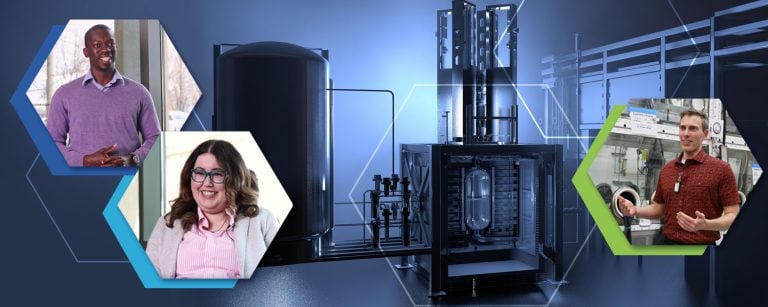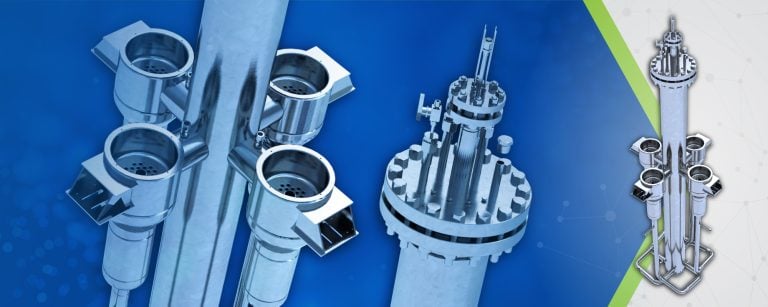Nuclear Energy
Safe, Efficient and Always On.
Nuclear Energy Innovations from INL.
INL News | Nuclear Energy
When asked to describe her job within the Molten Chloride Reactor Experiment (MCRE), Kristy Spencer smiled. “Whenever the project needs...Read More
It’s Tuesday morning in early June and the Idaho National Laboratory’s (INL) Transient Reactor Test Facility (TREAT) control room is...Read More
In the spring of 2020, a team of engineers at the Idaho National Laboratory (INL) embarked on a groundbreaking project...Read More
Nation’s Nuclear Energy Laboratory
INL leads the nation’s advanced nuclear energy research, with scientists and engineers improving reactor efficiency and aiding space exploration. INL’s cutting-edge work is making nuclear a more affordable and versatile component of the nation’s energy future.
Accelerating Nuclear Energy
As the nation’s nuclear energy laboratory, Idaho National Laboratory’s (INL) unique nuclear infrastructure and facilities, expertise and capabilities are not just valuable, but essential to America’s energy future. The nuclear energy future we have long envisioned is no longer a distant possibility and we are partnering with institutions across the country to make it a reality. The path to energy dominance runs through Idaho. Together, we will power America’s next chapter.
Key Projects
Research Capabilities
Our People
The Nuclear Energy team at Idaho National Laboratory (INL) is dedicated to advancing the safe and efficient use of nuclear energy. This team works on cutting-edge research and development projects, focusing on reactor design, nuclear fuel cycles, and waste management solutions. By leveraging state-of-the-art facilities and collaborating with industry leaders, academic institutions, and government agencies, the INL Nuclear Energy team aims to address the critical challenges facing nuclear power. Their efforts contribute significantly to national energy security and technological innovation in the nuclear energy sector.
Facilities
INL is leading the nation’s research in advanced nuclear energy technology. Our scientists and engineers study reactors that can enhance reliable domestic energy, materials that can optimize performance of nuclear reactors, and applications that help us explore worlds.
National Programs
Fact Sheets
Frequently Asked Questions
What is Nuclear Energy
Nuclear energy begins with a natural process called fission. Fission occurs when a neutron splits an unstable atom, like uranium, into two smaller atoms. This process releases heat as well as more neutrons that can split other atoms. In a nuclear reactor this process is controlled and sustained to produce energy continuously.
Is nuclear energy safe?
Nuclear energy is safe. Statistics show that nuclear energy is one of the safest forms of energy production. INL and other organizations are working on advanced nuclear reactor technologies that have passive safety features. This means they prevent accidents using the natural laws of physics without the need for electronics or human intervention. Nuclear options present a safe alternative to traditional energy sources and complement their variable production.
How does a nuclear reactor work?
What is the future of nuclear energy?
The nuclear energy industry is pursuing a wide range of new systems that will be demonstrated within the next decade. These reactors use materials and technologies that allow for the reactors to be smaller, more flexible and operate at higher temperatures. These higher temperatures result in more efficient electricity generation and heat for industrial processes, along with reduced costs.
The U.S. Department of Energy’s Advanced Reactor Demonstration Program is offering cost-shared partnerships with industry to support the development and demonstration of advanced reactors.
What is nuclear energy’s relationship to other energy sources?
What is a user facility?
A user facility is a federally designated facility that can be used by anyone to advance science. A panel of experts evaluates proposals, selects research of value and assigns time in the facility. If the research findings are made public, the facility is free to use.
INL runs three user facilities, including the Nuclear Science User Facilities, which support universities, national laboratories and industry.
What is a microreactor?
What is a test reactor?
Test reactors are scientific instruments used to research and develop new materials. Test reactors are high-powered versions of research reactors, operated at DOE laboratories, and they are essential for ensuring the safe performance of advanced fuels and materials that will be used in commercial nuclear reactors, and in our nuclear Navy fleet. Scientists use test reactors to subject specimens to high levels of neutrons to safely determine how materials will stand up to long-term radiation exposure. INL maintains the world’s most powerful and flexible test reactors, including the Advanced Test Reactor and the Transient Reactor Test Facility. A new Versatile Test Reactor is under development to expand the nation’s nuclear material testing capabilities.
What can nuclear reactors do besides produce power for the electrical grid?
Since reactors produce large quantities of heat, they can provide energy for other purposes like hydrogen production, water purification and delivering heat to help decarbonize certain industries.
Nuclear fission also plays a role in space exploration. INL has provided five different radioisotope power sources to NASA spacecraft, including the power source for NASA’s Mars Perseverance rover. And INL is involved in the development of space fission power systems that will support future missions.



